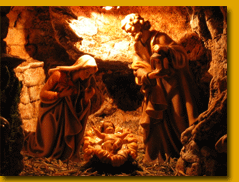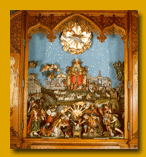Admonter Krippenwerkstatt
Mangers have been constructed in Europe for over 800 years. In 1223, St. Francis of Assissi contracted John of Grecci to build a manger with a cradle, the Christ Child, oxen and a donkey. St. Francis' goal in constructing the manger was similar to what it is today; to better understand the Miracle of Christ so that people could see the humble surroundings into which the Son of God came into the world of men.  As a builder of mangers, I am trying to translate the events of 2000 years ago into today's world. Each manger is a unique interpretation of the Birth of Christ. In building my mangers, I am drawing on history, but taking license in how they are constructed. There are two basic styles; traditional Alpine and those set in the Holy Land. Mangers set in the Holy Land place Jesus and the Holy Family in a cave or in a ruined house. This emphasizes the rise of the Christ Child from his humble beginnings to his place at the right hand of God in the Kingdom of Heaven. Or, that Jesus was born a new Adam from the clay of the earth. The most popular mangers from the Alpine Region place the Christ Child in stables or farmhouses that reflect traditional landscapes of the area, thereby bringing Jesus closer to home. The Tyrolian mangers are acknowledged as the best known. These depict scenes from the Tyrol that provided the people of the mountains and valleys with a sense of Christian tradition, home and the Christmas season. The Tyrol is too far for most people to visit, so rather than focus solely on the Tyrol, I would like to create mangers that reflect the Holiday traditions from different parts of Austria (or elsewhere). I am also hoping to bring the ancient traditions and stories about the birth of Christ into the modern world.
By doing this, Admonter Krippenwerkstatt follows in the footsteps of a long line of craftsman who build manges. The beliefs practiced by Christians living in the Gesause (south central Austria in the Alps) and surrounding areas have always been reflected in their religious artwork, including mangers. For example, in areas where the primary industries were mining and forestry, artists created mangers encased in glass boxes that depicted their guilds, work and lifestyles. The mangers of Eisenwurzen are a classic example of this. They not only showed life in the region, but utilized common materials found in their lives and workplaces in the mangers; materials such as quartz and other crystals. The use of these materials underscored how Jesus was a child from humble beginnings. Building the mangers in glass boxes protected and preserved the mangers so that they did not have to be rebuilt or repaired every year, and would provide continuity of tradition. As a builder of mangers, I am trying to translate the events of 2000 years ago into today's world. Each manger is a unique interpretation of the Birth of Christ. In building my mangers, I am drawing on history, but taking license in how they are constructed. There are two basic styles; traditional Alpine and those set in the Holy Land. Mangers set in the Holy Land place Jesus and the Holy Family in a cave or in a ruined house. This emphasizes the rise of the Christ Child from his humble beginnings to his place at the right hand of God in the Kingdom of Heaven. Or, that Jesus was born a new Adam from the clay of the earth. The most popular mangers from the Alpine Region place the Christ Child in stables or farmhouses that reflect traditional landscapes of the area, thereby bringing Jesus closer to home. The Tyrolian mangers are acknowledged as the best known. These depict scenes from the Tyrol that provided the people of the mountains and valleys with a sense of Christian tradition, home and the Christmas season. The Tyrol is too far for most people to visit, so rather than focus solely on the Tyrol, I would like to create mangers that reflect the Holiday traditions from different parts of Austria (or elsewhere). I am also hoping to bring the ancient traditions and stories about the birth of Christ into the modern world.
By doing this, Admonter Krippenwerkstatt follows in the footsteps of a long line of craftsman who build manges. The beliefs practiced by Christians living in the Gesause (south central Austria in the Alps) and surrounding areas have always been reflected in their religious artwork, including mangers. For example, in areas where the primary industries were mining and forestry, artists created mangers encased in glass boxes that depicted their guilds, work and lifestyles. The mangers of Eisenwurzen are a classic example of this. They not only showed life in the region, but utilized common materials found in their lives and workplaces in the mangers; materials such as quartz and other crystals. The use of these materials underscored how Jesus was a child from humble beginnings. Building the mangers in glass boxes protected and preserved the mangers so that they did not have to be rebuilt or repaired every year, and would provide continuity of tradition.  The glass manger built by Joseph Stammel may be seen in the Stift Admont. However, the artwork is no longer in its original glass box which was damaged in the fire in 1865. Fortunately, the hand carved figures survived the fire and may be seen today in the Alter dedicated to St. Barbara. In Stammel's work, the manger shows the three scenes in the circle of the nativity consisting of the appearance of the angel of Lord to the shepherds in the field, the Epiphany of Christ and the appearance of the Magi. The manger may be the most beautiful of all mangers in the Alpine region. It is quite obvious that the work was done by a true believer and a devote Christian. When viewing the manger, visitors will be amazed at the detail in the work and its allegorical significance.
I have been building mangers for 25 years. He was inspired as a teenager by the mangers in his home town of Siegen in Westphalia. My first project was to build a manger that depicted the traditional German wooden beam construction, much like those seen in England. I have spent a great deal of time researching the history of mangers and has used that knowledge to enhance my craft. Having resided in Admont for over ten years, I am now building mangers modeled on traditional Austrian alpine barns and homes. I am, however, also building the more traditional mangers that depict the Holy family in the Holy Land in caves or ruins. To people around the world who look at mangers, I want people to realize that the real beauty of a manger may be found in the heart of the true believer. The glass manger built by Joseph Stammel may be seen in the Stift Admont. However, the artwork is no longer in its original glass box which was damaged in the fire in 1865. Fortunately, the hand carved figures survived the fire and may be seen today in the Alter dedicated to St. Barbara. In Stammel's work, the manger shows the three scenes in the circle of the nativity consisting of the appearance of the angel of Lord to the shepherds in the field, the Epiphany of Christ and the appearance of the Magi. The manger may be the most beautiful of all mangers in the Alpine region. It is quite obvious that the work was done by a true believer and a devote Christian. When viewing the manger, visitors will be amazed at the detail in the work and its allegorical significance.
I have been building mangers for 25 years. He was inspired as a teenager by the mangers in his home town of Siegen in Westphalia. My first project was to build a manger that depicted the traditional German wooden beam construction, much like those seen in England. I have spent a great deal of time researching the history of mangers and has used that knowledge to enhance my craft. Having resided in Admont for over ten years, I am now building mangers modeled on traditional Austrian alpine barns and homes. I am, however, also building the more traditional mangers that depict the Holy family in the Holy Land in caves or ruins. To people around the world who look at mangers, I want people to realize that the real beauty of a manger may be found in the heart of the true believer.
Günter Neuser
|



















